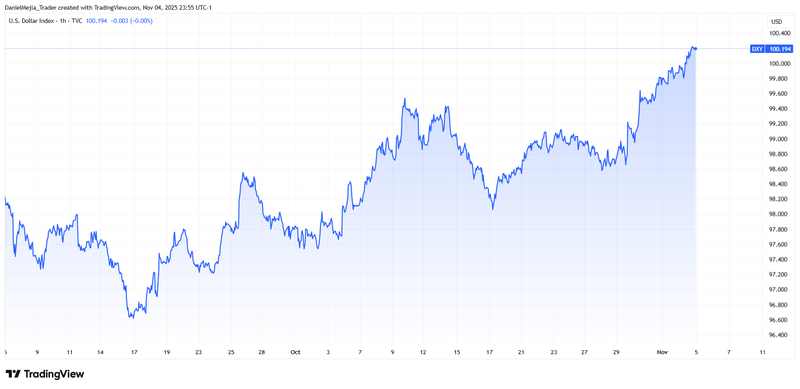Private hiring dips amid US shutdown; dollar strengthens
Private-sector job postings have fallen sharply while the US federal funding lapse approaches record length, generating heightened market uncertainty. US equities fell on the shutdown-related risks, while the US dollar strengthened as markets questioned the likelihood of a December Fed rate cut.

The Indeed Job Postings Index fell from 161.4 in April 2022 to 101.7 in October 2025, a decline of c. 37 per cent.
The US government shutdown is on course to become the longest in history if it continues through Wednesday, 5 November.
US major indices fell amid the weak private hiring signal and political uncertainty; in contrast, the dollar index (DXY) rose c. 0.31 per cent.
Oil benchmarks retreated as OPEC+ agreed a modest increase in December production and the stronger dollar made commodities more expensive in foreign currency terms.
Market pricing for a 25-basis-point Fed cut in December is in flux as policymakers await official data disrupted by the shutdown.
Indeed: private job postings fall sharply amid weak employment outlook
Private labour-market data from the Indeed company indicate a pronounced deterioration in US hiring momentum. The Indeed Job Postings Index, which tracks online job adverts, declined from a peak of 161.4 in April 2022 to 101.7 in October 2025 — a fall of approximately 37 per cent (see Figure 1). Although the index is not an official series, it provides a timely gauge of labour demand while federal reporting schedules are disrupted by the shutdown.
The Job Openings and Labor Turnover Survey (JOLTS) — the closest official analogue — has not been published recently because of the federal funding lapse; the most recent JOLTS release for August already signalled a downtrend in vacancies. In the absence of timely official releases, market participants have used private indicators such as Indeed’s series to inform expectations: the CME Group’s FedWatch Tool implied a c. 69 per cent probability of a 25-basis-point cut in December at one point, although conditions remain fluid.
In response to the weak hiring signal and ongoing political uncertainty, US equity markets fell: the Dow Jones declined 0.53 per cent to 47,085, the S&P 500 fell 1.17 per cent to 6,771, and the Nasdaq-100 dropped 2.07 per cent to 25,435.

Figure 1. Indeed Job Postings Index (2020-2025). Source: Own analysis using data from Economic Research by Indeed (November 4, 2025).
The shutdown approaches record length
Negotiations in Congress remain stalled and, if the impasse continues through Wednesday, 5 November, the current funding lapse will surpass the previous record (35 days, December 2018–January 2019) and become the longest shutdown in US history. The political divide centres on competing priorities: Democrats seek additional spending for healthcare and social programmes, while Republicans prioritise defence and innovation-related funding.
Beyond the immediate fiscal and operational costs, a prolonged shutdown complicates macroeconomic policy by delaying the release of key official statistics — notably employment data — at a time when the Federal Reserve requires accurate information to calibrate policy. The prospect of further months without comprehensive official data adds uncertainty to the Fed’s deliberations ahead of its December meeting.
Dollar strengthens as Fed cut probability is reassessed
The US dollar index (DXY) appreciated by c. 0.31 per cent to 100.20 amid growing doubts about the likelihood of a further 25-basis-point reduction in December. Chair Jerome Powell emphasised the Fed’s data dependence and the need for complete official information before committing to additional easing; the shutdown has introduced ambiguity into that data flow. Inflation remains above the 2 per cent objective (the PCE price index at c. 2.74 per cent), while labour-market indicators point to softer demand.
A hawkish tilt in Fed communications tends to support the dollar; the currency has appreciated by roughly 3.5 per cent over the last two months. Sterling also weakened — by about 0.90 per cent — after comments from the UK finance minister, Rachel Reeves, who highlighted structural challenges including high debt, weak productivity and high inflation. In addition, the financial minister signalled that her budget choices would focus on reducing inflation.

Figure 2. Dollar index (last two months). Source: data from the Intercontinental Exchamge. Figure obtained from TradingView.
Oil eases on OPEC+ supply plans and a firmer dollar
Brent and WTI futures fell modestly as OPEC+ agreed to a small production increase for December and signalled a pause in additional increases for Q1 2026. Prospects of marginally higher supply at year end, combined with the stronger dollar (which raises the dollar price of oil for holders of other currencies), likely contributed to the decline.
At the close, the Brent futures contract (BRNF6) was down c. 0.69 per cent at $64.44 per barrel and the WTI contract (CLZ5) fell c. 0.78 per cent to $60.21 per barrel. Market participants will continue to monitor OPEC+ communications and actual shipment flows for a clearer view of near-term balances.
If you're interested in trading indices, foreign exchange, shares, or commodities, consider exploring the CFD contracts offered by Equiti Group. Please note that trading leveraged derivatives involves a high level of risk and may not be suitable for all investors.
